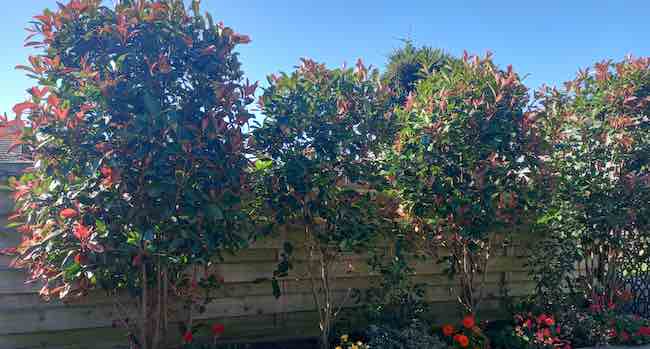Photinia Problem – Large Newly Planted Photinia Dies

Photinia or red robin problems with being one of two causes:
Firstly when a large plant is moved because a lot of its roots are damaged it drops or shuts down a lot of the top growth i.e the leaves and branches. This is to try to balance itself so that the volume of the plant below ground and the volume of the plant above ground match. This makes sure that the roots can supply the branches and leaves with enough water and nutrients to create balanced growth.
What you are describing could be the above however as you have explained some of the new leaves seem to be now affected as well so it might be a disease called photinia leaf spot.
Disease Profile: Entomosporium leaf spot of photinia.
This article was originally published in The Dirt Doctor’s Dirt Magazine, in April 2003
Description: Spots on mature leaves have ash brown to light grey centres with a distinctive deep red to the maroon border. At the centre of the leaf, there are small black spots that are producing spores. Many small spots may grow together to form large maroon blotches on heavily diseased leaves. Low levels of this fungus usually cause little more than cosmetic damage, but the spores are a source of future infections. Severe infections cause heavy defoliation, which increases the plant’s sensitivity to cold injury and other diseases and insects.
Disease Cycle: Spots on the leaves and young shoots are important in the survival of the Entomosporium leaf spot fungus. During cool, wet weather(60 to 80 degrees F., 12- to 24-hour leaf wetness), small, circular, often bright red spots appear on leaves of red-tip photinia and Indian hawthorn. Fallen, diseased leaves are less important sources of fungus. Masses of spores are released during periods of wet weather from the fungal spore-producing structures in the centre of the spots from late winter through much of the year except during the hot periods of summer. These spores are spread to healthy foliage by a combination of splashing water and wind.
Control: Cultural practices can reduce the chance of this disease. The best control is prevention. Do not plant photinia or Indian hawthorn areas that accumulate water or have poor drainage. Red tip photinia is susceptible to cotton root rot(Phymatotrichum omnivore)and this fungal disease is exacerbated by poor drainage. Damage from this root disease can lead to weakened plants that are subsequently more susceptible to problems such as leaf spots. Space plants improve air circulation around them and promote rapid drying of leaves.
Do not water or fertilize more than necessary to avoid promoting excess new growth, which is more susceptible to disease. If plants require supplemental irrigation, water early in the morning so the leaves dry quickly. Fallen diseased leaves can be removed as they are a potential source of future infections, but are not the most significant source. Moving them could cause an unintended dispersal of more spores. You may try covering fallen diseased leaves with cedar mulch to accelerate their decomposition and suppress the fungus. Use a potassium bicarbonate spray on the foliage of heavily infected plants(4 teaspoons/1gallon water), or cornmeal juice. Removing severely diseased plants that have also been damaged by cold injury may be necessary as replacing them with another plant species not susceptible to the disease. Improve your soil health by following the basic organic program.
GardenAdvice AI agent answering your gardening questions
FAQ





